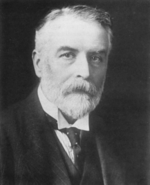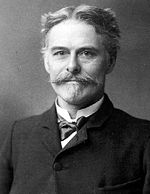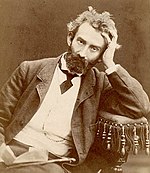Portal:Marine life/Selected Biography/Archives
These are all of the biographies previously selected for showing on the Marine life Portal main page.
August, 2006[edit]

Jacques-Yves Cousteau (11 June 1910 – 25 June 1997) was a French naval officer, explorer, ecologist, filmmaker, photographer and researcher who studied the sea and all forms of life in water. He co-developed the aqua-lung, pioneered marine conservation and was a member of the Académie française.
Cousteau was born in Saint André de Cubzac, France to Daniel and Elizabeth Cousteau on June 11, 1910 and died in Paris, France. He is generally known in France as le commandant Cousteau ("Commander Cousteau"). Worldwide, he was commonly known as Jacques Cousteau or Captain Cousteau.
Cousteau liked to call himself an "oceanographic technician". He was in reality a sophisticated lover of nature. His work permitted many people to explore the resources of the "blue continent".
His work also created a new kind of scientific communication, criticised at the time by some academics. The so-called divulgationisme, a simple way of sharing scientific concepts, was soon employed in other disciplines and became one of the most important characteristics of modern TV broadcasting.
More on Jacques-Yves Cousteau
September, 2006[edit]
Ed Ricketts studied zoology at the University of Chicago and was influenced by his teacher, W. C. Allee, but Ricketts dropped out without a degree.
He was fictionalized by his friend John Steinbeck as the character, "Doc", in the novels, Cannery Row and Sweet Thursday, as "Doc Burton" in In Dubious Battle, "Casy" in The Grapes of Wrath and "Doctor Winter" in The Moon is Down. Steinbeck also co-wrote the narrative portion of Sea of Cortez with Ricketts, and later wrote a short remembrance of Ricketts in an introduction to the Viking edition published as The Log from the Sea of Cortez (1951, reprinted by Penguin and cited below).
From 1927 to 1948, Rickett's Pacific Biological Laboratory at 800 Ocean View Avenue in Monterey was a salon of sorts, where writers, artists and other luminaries would gather. Bruce Ariss, Joseph Campbell, Henry Miller, John Steinbeck, Lincoln Steffens, and Francis Whitaker were just some of the visitors who flocked to Doc's lab.
More on Ed Ricketts
October, 2006[edit]

Sir John Murray (March 3, 1841–March 16, 1914) was a pioneering Scots-Canadian oceanographer and marine biologist.
Murray was born on 3 March 1841, at Cobourg, Ontario, Canada, to Scottish parents who had emigrated seven years earlier. He returned to Scotland to study, firstly at Stirling High School, and then at the University of Edinburgh, but soon left to join a whaling expedition to Spitsbergen as ships' surgeon in 1868.
He returned to Edinburgh to complete his studies in geology under Sir Archibald Geikie and natural philosophy under Peter Guthrie Tait. Tait introduced Murray to Charles Wyville Thomson who had been appointed to lead the Challenger Expedition. In 1872, Murray joined Wyville Thomson as his assistant on this four-year expedition to explore the deep oceans of the globe. After Wyville Thompson succumbed to the stress of publishing the reports of the Challenger Expedition, Murray took over, and edited and published over 50 volumes of reports, which were completed in 1896. He was knighted (K.C.B) in 1898. Murray was killed when his car overturned near his home on March 16 1914 at Kirkliston, Edinburgh, and he is buried at the nearby Dean Kirkyard.
More on John Murray
November, 2006[edit]

George Albert Boulenger (born Brussels, Belgium, October 19, 1858 died Saint Malo, France, November 23, 1937) was a British zoologist.
Boulenger was the only son of Gustave Boulenger, a Belgian public notary, and Juliette Piérart de Valenciennes. He graduated in 1876 from the Free University in Brussels with a degree in natural sciences and worked for a while at the Museum of Natural History of Brussels as an assistant naturalist studying amphibians, reptiles, and fishes. He also made frequent visits during this time to the Muséum National d'Histoire Naturelle in Paris and the British Museum in London.
In 1880, he was invited to work at the Natural History Museum by Dr. Albert C. L. G. Günther and assigned to the task of cataloguing the amphibians in the collection. His position in the British Museum meant that he had to be a civil servant of the British Empire, and so became a naturalized British subject. In 1882 he became a first-class assistant in the Department of Zoology and remained in that position until his retirement in 1920.
More on George Albert Boulenger
December, 2006[edit]

Rachel Louise Carson (27 May 1907 – 14 April 1964) was a Pittsburgh, Pennsylvania-born zoologist and marine biologist whose landmark book, Silent Spring, is often credited with having launched the global environmental movement. Silent Spring had an immense effect in the United States, where it spurred a reversal in national pesticide policy.
Rachel Carson was born in 1907 on a small family farm near Springdale. As a child, she spent many hours learning about ponds, fields, and forests from her mother. She originally went to school to study English and creative writing, but switched her major to marine biology. Her talent for writing would help her in her new field, as she resolved to "make animals in the woods or waters, where they live, as alive to others as they are to me". She graduated from the Pennsylvania College for Women, today known as Chatham College, in 1929 with magna cum laude honors. Despite financial difficulties, she continued her studies in zoology and genetics at Johns Hopkins University, earning a master's degree in zoology in 1932.
More on Rachel Carson
January, 2007[edit]

Edward Drinker Cope (July 28, 1840–April 12, 1897) was an American paleontologist and comparative anatomist.
Cope was born in Philadelphia to Quaker parents. At an early age he became interested in natural history, and in 1859 communicated a paper on the Salamandridae to the Academy of Natural Sciences at Philadelphia. It was about this time that he became affiliated with the Megatherium Club at the Smithsonian Institution in Washington, D.C. He was educated partly in the University of Pennsylvania and, after further study and travel in Europe, was appointed curator to the Academy of Natural Sciences in 1865, a post which he held until 1873. From 1864–1867 he was professor of natural science at Haverford College, and in 1889 he was appointed professor of geology and palaeontology by the University of Pennsylvania.
More on Edward Drinker Cope
February - March, 2007[edit]
Felix Anton Dohrn ( September 29, 1840 - September 26, 1909) was a prominent Darwinist and the founder and first director of the Stazione Zoologica, Naples, Italy.
Dohrn was born in Stettin, Pomerania, present day Poland, in 1840, into a wealthy middle class family. His grandfather, Heinrich Dohrn, had been a wine and spice merchant, and had made the family fortune by trading in sugar. This wealth allowed Anton's father, Carl August, to devote himself to his various hobbies; travelling, folk music and insects. Anton, the youngest son, read zoology and medicine at various German universities (Königsberg, Bonn, Jena and Berlin), with little application or enthusiasm for his studies.
More on Anton Dohrn
April, 2007[edit]

Nicholai Nicholaevich Miklukho-Maklai (Николай Николаевич Миклухо-Маклай in Russian) (1846 – 1888) was a Russian ethnologist, anthropologist and biologist.
Miklukho-Maklai was born in a temporary workers camp near Novgorod, a son of a civil engineer working on the construction of the Moscow-Saint Petersburg Railway. He attended a grammar school in Saint Petersburg, then went on to study at St. Petersburg University.
He travelled and studied widely in Europe, and became a close friend of the biologist Anton Dohrn, with whom he helped conceive the idea of "research stations" while staying with him at Messina, Italy.
Miklukho-Maklai left St Petersburg for Australia on the schooner Vityaz. He arrived in Sydney on 18 July, 1878. A few days after arriving, he approached the Linnean Society and offered to organise a zoological centre. In September 1878 his offer was approved. The centre, known as the Maritime Biological Centre, was constructed by prominent Sydney architect, John Kirkpatrick. This was the first marine biological research institute in Australia.
He visited Papua New Guinea on a number of occasions, and lived amongst the native tribes, writing a comprehensive treatise on their way of life and customs.
More on Nicholai Miklukho-Maklai
